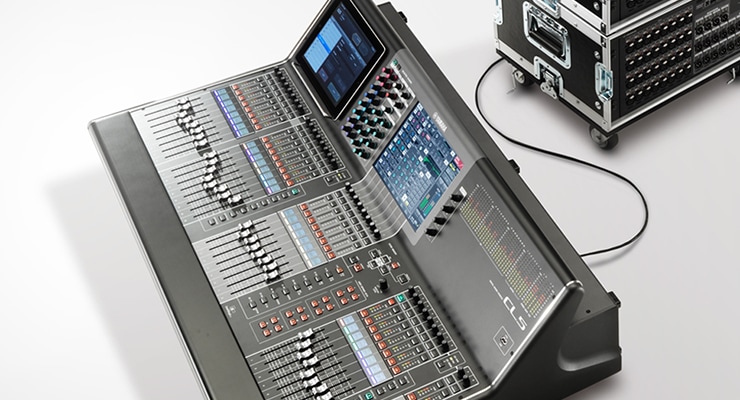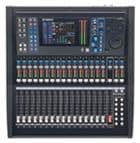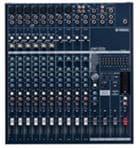Better Sound for Commercial Installations
Part 3: Mixers and Processors

01. Digital and Analog Mixers
The mixing console or "mixer" is a central component of most sound systems. In fact, the mixer used will have a large influence on the operability and efficiency of the entire system. One of the first decisions that will have to be made when designing a new sound system is whether a digital or analog mixer will be used.
Digital Mixers are Rapidly Gaining Ground
Described in the simplest terms, the difference between analog and digital mixers is whether audio signals are internally processed in their original analog form or converted to and processed in digital form. Digital mixers are rapidly gaining popularity for their convenience, expandability, and resistance to noise (see "The Merits of Digital Sound" in Part 1). But there are still situations in which analog is preferred. Let's take a look at the features of each.
Digital Mixer Features
Five of the most important features of digital mixers are listed below. All of these features are related to the benefits described in The Merits of Digital Sound" in Part 1. It might be easier to grasp the "big picture" if you go back and review that information as well.
(1) Settings can be pre-programmed and recalled when necessary
Most digital mixers feature some kind of memory into which settings can be stored and then instantly recalled whenever they are needed. This can be a tremendous advantage in a banquet hall facility for example, where the required settings might change frequently for different types of events and different room configurations. Even if some fine tuning is required, the ability to simply recall a complete set of basic parameters that are close to what is needed can dramatically reduce the time and effort required to set up for an event. And if a mistake is made, it's easy to revert to the basic settings.
(2) Mixing and processing features that only digital can provide

Digital technology has enabled the development of a number of mixing functions that were simply not available in analog systems. Automatic feedback suppression is one example. Automatic "ducking" that decreases the BGM level while an announcement is being made is another. More details will be provided in the "Automated Mix Functions" section.
Many digital mixers also feature built in signal processing functions such as effects that are designed to suit the mixer's intended applications. This makes it unnecessary to purchase extra external signal processing devices, thus significantly reducing overall system cost as well as installation space. This is a radical departure from analog systems for which additional equipment had to be purchased and installed to provide the signal processing functions required by each individual application. There are analog mixers that include some built-in processing functions, but unlike digital mixers in which all of the necessary processing can be implemented through software, additional processing capability has a direct influence on the cost and physical size of an analog mixer. For the same mixing and processing capabilities, a digital mixer will almost always offer superior economy.
(Figure: Digital technology makes it possible to offer convenient mix support features. )
(Photo: Yamaha LS9-16))
(3) Expansion and external devices
Expandable digital mixers make it possible to connect to a wide variety of external devices. Touch panel controllers, for example, can make day-to-day operation of a specified set of frequently used parameters easy for even inexperienced users, while keeping parameters that should not be changed hidden. More details will be provided in the "Peripheral Equipment" section.
(4) Noise-resistant digital transmission
A sound system that is based on a digital mixer that uses digital transmission for audio signals will be highly resistant to induced noise, as described in the "The Merits of Digital Sound" section in Part 1. Since noise becomes more of a problem with longer transmission distances, the benefits of digital transmission in an audio installation increase as the size of the facility increases.
(5) Multiple functions in small spaces
Although analog mixers usually have one control per function, in a digital mixer it is possible to assign numerous functions to a single control, with function switching either via physical controls or virtual controls on a display. This makes it possible to pack a large number of functions into a relatively small space. If you compare analog and digital mixers that offer the same number of channels, you'll see that the digital mixers tend to be significantly smaller.
Analog Mixer Features
Analog mixers have two main advantages.
(1) Lower cost for a limited set of features
If only a few channels with a basic set of mixing features are required, a simple analog mixer may be a more economical choice than a digital mixer.
(2) Easy operation for first-time users

As mentioned above, analog mixers usually have one control per function, all of which are visible and directly accessible via the control panel. The control layout logically follows the mixer's signal flow and is therefore relatively easy to understand. This type of logical, easy operation can be an advantage in public halls and schools, for example, where a variety of people, some having little or no previous experience, may need to operate the system. In such situations it may be necessary to protect controls and functions that should not be changed with security covers.
That covers the basic differences between digital and analog mixers. Depending on the application, the choice of a digital or analog mixer can make a large difference in the operability and overall economy of the system. Next we'll look at another important consideration for mixer selection: configuration.
Contents
The sound systems that broadcast the information you're hearing have been carefully designed and installed to suit the needs of each individual facility.
This series offers information aimed at achieving the best possible sound in commercial installations, from the basics to equipment selection and day-to-day operation.








